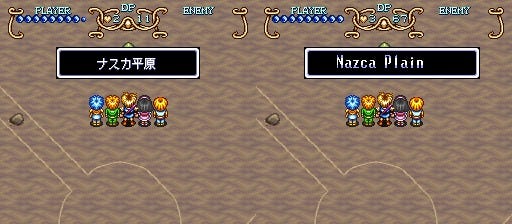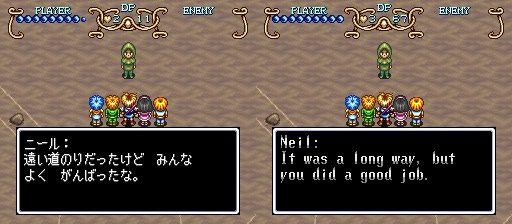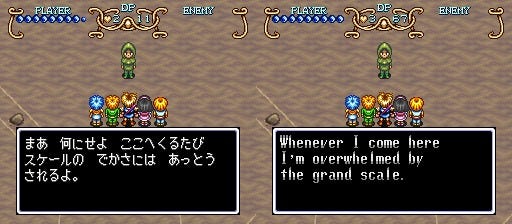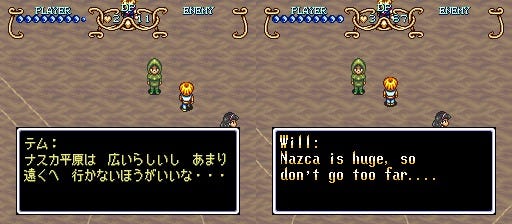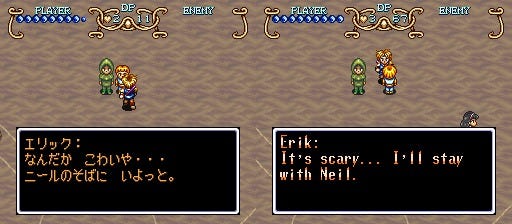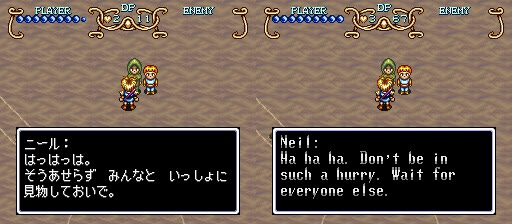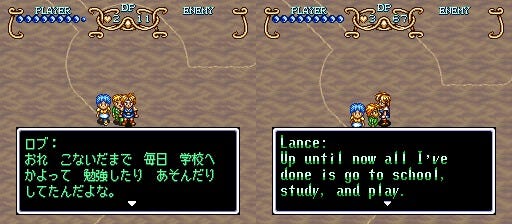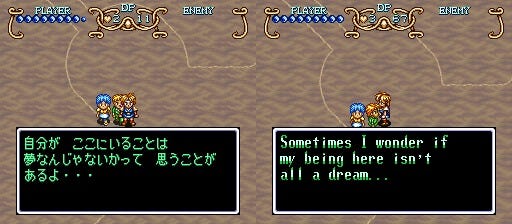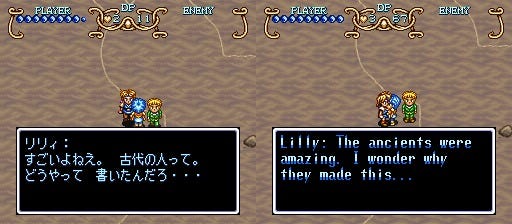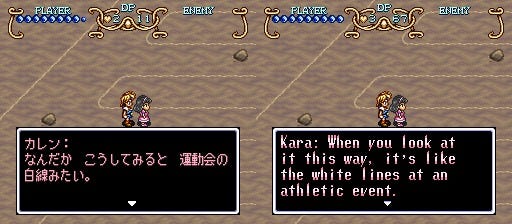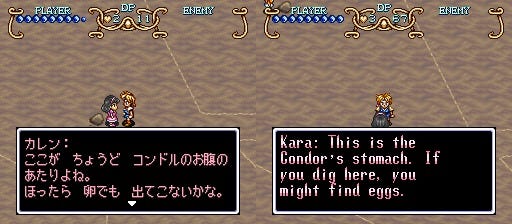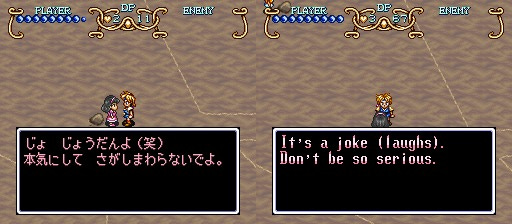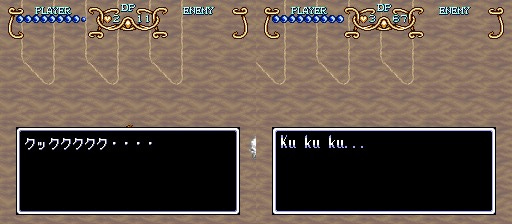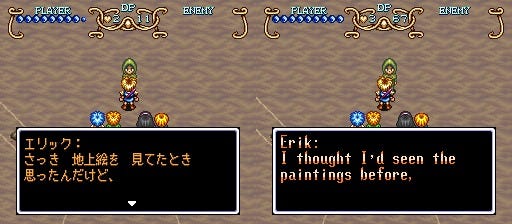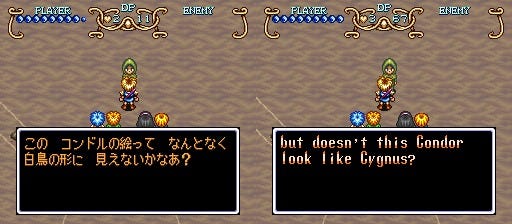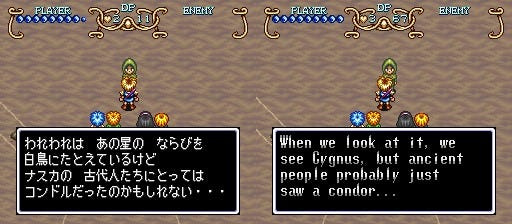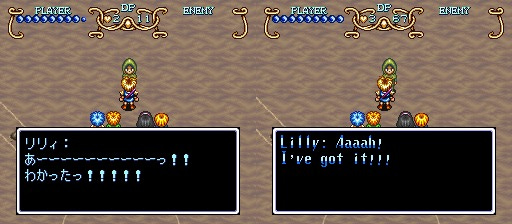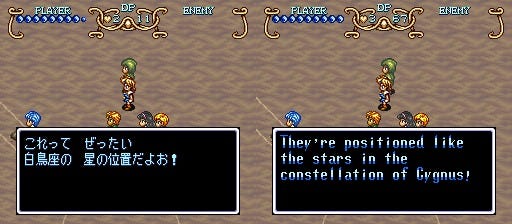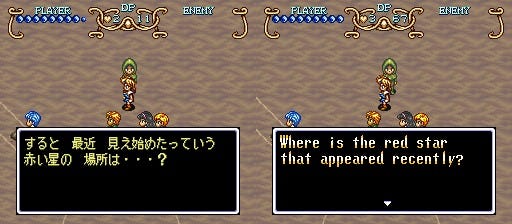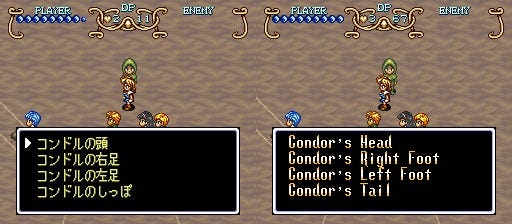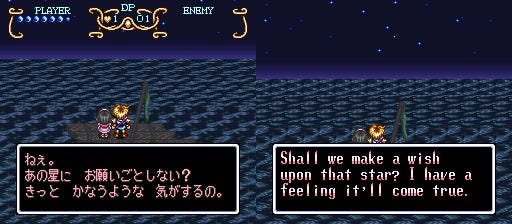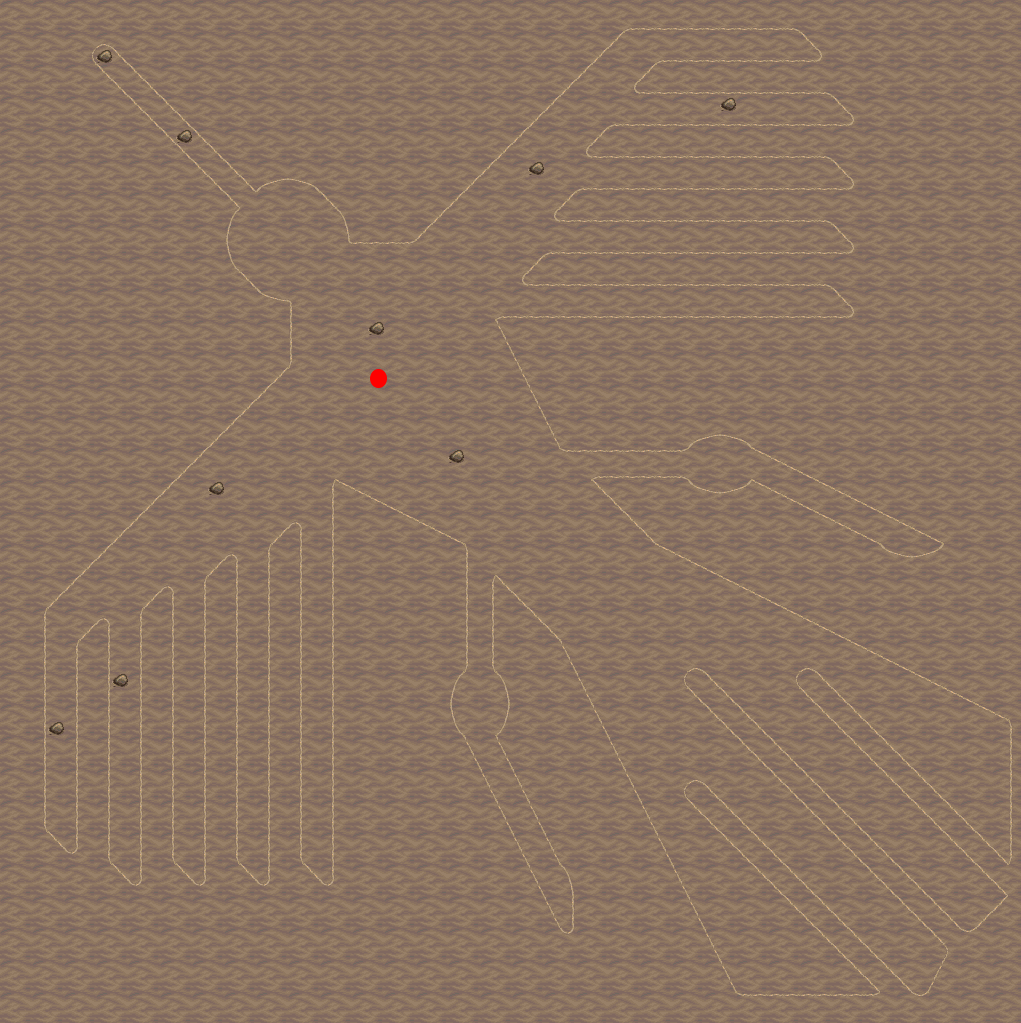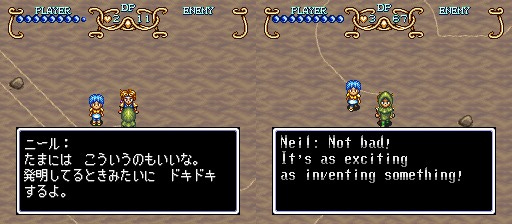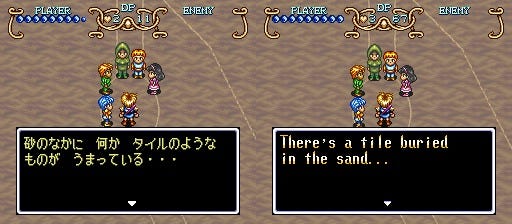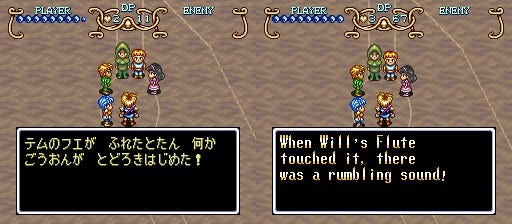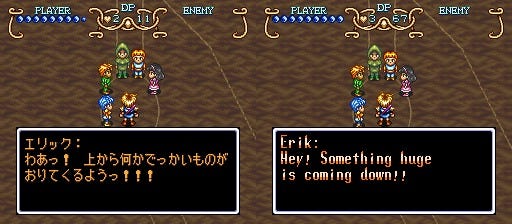Illusion of Gaia Translation Commentary Part 15: Neil, Nazca
Please do not take my overthinking as criticism
Disclaimers:
I’m an amateur. My advantage over the original translation is that I have no deadline pressure, and I have the modern internet to help me. I’m assuredly wrong about some of my translations.
Translation is hard. When I point out a mistranslation, it’s not a judgment of the original translator(s). They had a deadline and poor resources.
Please no jokes in the comments about Karen being a Karen. I really hate that trend.
Notation reminder:
JP: Original Japanese
T: My translation
OE: Original English
The party is off to Neil’s house in the woods. In the original JP, on the Mode 7 map, both Neil and Cottage are misspelled:
Inside we see Neil and his messy home:
JP: ニールの小屋
T + OE: Neil’s Cottage
Neil’s speech is in gray text that’s barely differentiable from the white text used for narration. It’s easier in English than in Japanese due to the shading on the letters.
JP: ニール: 開いてるから かってに はいんなっ。
テム: ニール。 ぼくだよ。 サウスケープの町の テムだよ。
T + OE: Neil: It’s open, come in.
Tim/Will: Neil. It’s me. Tim/Will from South Cape.
JP: ニール: おおっ! テムじゃないかっ!! ずいぶん たくましく なったな。
それに ずいぶん ぞろぞろいるけど テムの友達かい?
T: Neil: Oh! Well if it isn’t Tim! You’ve gotten so muscular.
And so popular. Are all of these people your friends?
OE: Neil: Oh! Will! You’ve gotten strong!
Are all of these people your friends?
After noticing that Tim is ずいぶん たくましく (zuibun takumashiku): very/surprisingly strong/burly/muscular, Neil says それに ずいぶん ぞろぞろいる (sore ni zuibun zorozoro iru): in addition, very/surprisingly in a crowd.
Karen pops off with some rudeness:
JP: カレン: この人 なんだか くさああい...
リリィ: なんてこと言うのっ! そおいうことは もっと 言い方って いうものがあるでしょっ!!
T: Karen: This guy’s a little stiiiiinky.
Lily: Good lord, Karen! There’s probably a better way to say that!
This time I’m on Lily’s side.
JP: この部屋は 鼻が ねじまがるくらい 素敵なかおりが ただよってますねぇ とかさぁ。
ニール: おいおい。 二人とも ずいぶん はっきり 物を 言う おじょうさんだね。
T: The smell in this room… is wonderful to high heaven. Yeah, that’s it.
Neil: Whoa! You two ladies are awfully direct, huh?
OE: There’s a wonderful smell in this room, isn’t there?
Neil: Hey, hey. Both of you talk pretty harshly.
But Lily’s way of saying the guy stinks is still transparent. She does say the smell is wonderful: 素敵 (suteki). But then she uses an idiom that means it reeks. She says it’s so wonderful that it wrinkles your nose. It’s less direct than Karen but it comes off as cheeky. OE simply has her say that it smells nice. Neil’s response then makes no sense, as only Karen has spoken harshly in OE.
I modified an English phrase associated with bad smells (stinks to high heaven). I also changed the punctuation and other words to show how disingenuous it sounds. You could translate it literally instead. The player would probably understand that good smells don’t wrinkle your nose, especially given Neil’s response.
JP: ずっと 発明に ぼっとうしていると 身なりにかまわなくなっちまうのさ。
でも 人に きらわれるほど ひどい においじゃないと 思うけどなあ。
T: When you get wrapped up in inventing something, you end up not caring about your appearance.
But I don’t think the smell is bad enough to turn people off.
OE: When you’re wrapped up in inventing something, you don’t care about your appearance.
I don’t think the smell is that bad. Not enough to hate me for it.
JP: この くつ下だって はきはじめてから まだ 一か月しか たってないんだぜ。
ロブ: オレ 3週間っていう きろくが あるけど 負けてるなあ。
T: It’s only been a month since I started wearing these socks.
Rob: My record is only 3 weeks. Guess I lose.
OE: I’ve only been wearing these socks for a month.
Lance: I’ve only had mine on for three weeks. I guess I lose!
It’s unclear in Japanese whether Rob’s record is for his whole life, or if he’s talking about an active streak. OE assumed the latter.
JP: カレン: この人たちってば 信じらんないっ!
もう 同じ空気を 吸ってるのも やだわっ!!
T: Karen: I can’t believe these guys!
I don’t want to breathe the same air as them!
OE: Kara: I can’t believe it!
I don’t want to breathe the same air as him!
JP: ニール: だからっ くつ下の話は もう いいんだよっ。
まあ とにかく くつろいでくれ。 テムの友達だもんな。 かんげいするよ。
T: Neil: Enough about my socks already.
Make yourselves at home. You’re Tim’s friends, so you’re welcome here.
OE: Neil: I’ve heard enough about my socks.
Make yourself at home. You’re Will’s friends. Welcome.
At this point, if you hurry and talk to Lily before the characters move into position, you can catch this line. Once they’re in position, Karen will be blocking Lily and you can’t talk to her.
JP: リリィ: テムのいとこじゃ 悪口いえないけど これが 発明家ねえ...
T: Lily: I don’t want to badmouth your cousin, but this guy…
OE: I shouldn’t say anything bad about Will’s cousin, but this inventor…
OE is literally correct but I think it sounds bad in English. I changed inventor to guy to sound more natural.
Karen and Rob have nothing new to say. Erik:
JP: エリック: この発明品を モリスが見たら よろこぶだろうなぁ...
T: Erik: I’m sure Morris would be delighted to see these inventions.
OE: Erik: Seth will be pleased when he sees this invention…
JP uses a conditional form for see: 見たら (mitara). The conditional can mean when X sees, after X sees, or if X sees. Often you have to use context to figure out the correct intention. Erik doesn’t know if Morris is even alive, so the correct interpretation must be if Morris sees, would be delighted rather than when Morris sees, will be delighted. In OE, Erik seems to still live in a fantasy world where he’s sure to see his friend again.
Of course, I always feel obligated to try to leave when I’m not supposed to:
JP: ニール: テム どこへ行くんだ? せっかく きたんだし もっと ゆっくり していけよ。
T: Neil: Where are you going? Since you’ve come all this way, you should stick around a while.
OE: Neil: Will, where are you going in such a hurry? Stay a while.
JP: ニール: この前 テムに会ってから 2年 くらいたつのかな?
あれから ずいぶん いろんな 発明をしたよ。
T + OE: It’s been about two years since we last met, hasn’t it?
I’ve invented lots of things since then.
Neil really seems to like the word ずいぶん (zuibun - very/surprisingly/considerably). I wonder if this is some kind of stereotype?
JP: この部屋には ぼくの自信作の 発明品が 4つばかり置かれている。 さがしてごらん。
T: Four of my best inventions are here in this room. Check them out.
OE: The four inventions in this room are my best work. Have a look.
You have to look at Neil’s 4 inventions before the story will progress.
JP: それは カメラ。 景色を そっくりそのまま 印画紙に 焼きつけることができる機械さ。
欠点は 写すのに 30分近く かかることなんだ。
T: That’s a camera. It’s a machine that can burn a copy of a scene exactly as is onto printing paper.
The drawback is that it takes about 30 minutes.
OE: That’s a camera. It will burn a copy of a scene onto printing paper.
The problem is that it takes almost 30 minutes.
JP: 景色は 動かないからいいけど 人を 写す場合は 30分もの間 まばたきも しちゃいけない。
この機械を作ったときは おかげで 目が ウサギのように 真っ赤に なってしまったよ。
T: Landscapes are fine because they don’t move, but to photograph a person means they can’t blink for 30 minutes.
Because of that, when I made it, my eyes were turning bright red like a rabbit’s.
OE: Scenery doesn’t move, but to photograph a person means they can’t move for 30 minutes.
When I used it, the eyes turned bright red like a rabbit’s.
I really struggled with interpreting the second sentence. Neil’s unquestionably saying Because of when I made this machine, eyes turned bright red like rabbit’s. I thought he was talking about the red-eye effect in photography. Which didn’t make sense because 1) This obviously isn’t flash photography, and 2) He’s talking about when he made the machine, not when he used it. Eventually I figured that he’s saying he had to test the machine out when he made it, and doing so required him to not blink for 30 minutes. That’s why his eyes turned red. So I treated おかげで (okagede - thanks to / because of) as referring to the previous sentence, rather than referring to when I made this machine. It’s not technically what he’s saying, but I think it’s clearer.
It’s funny that this line didn’t come off as a complete non sequitur in OE, even though they took out the part about not blinking for 30 minutes, because you’d figure he’s just talking about the red-eye effect. It still comes out weird because he says the eyes rather than my eyes.
JP: ニール: それは さんそボンベ。 中には 空気が入っているのさ。
それをつければ 水の中でも 息が できるんだけど 空気が 1分くらいしか もたないんだ。
T: Neil: That’s an oxygen tank. There’s air inside.
If you wear it, you’ll be able to breathe even underwater. But it only holds about a minute’s worth of air.
OE: Neil: That’s an oxygen tank. There’s air inside.
With this you can breathe underwater, but there’s only one minute’s worth of air inside.
JP: 空気を 圧縮できれば 長時間 もぐれるんだろうけど その方法が 思いつかないんだよ。
T: I think compressing the air would allow you to dive for longer, but I don’t know how to do it.
OE: Compressing the air would let you stay underwater longer, but I don’t know how to do it.
JP: ニール: それは エアプレインのつばさ。
鳥のように 空を飛びたいっていう 人類の夢を かなえてくれる 素敵な 機械の 一部だよ。
T: Neil: That’s an airplane wing.
It’s part of a wonderful machine that will make mankind’s dream of flying through the sky like a bird come true.
OE: Neil: Those are airplane wings.
It’s part of a machine that will fulfill man’s dream of flying in the air like a bird.
JP: 本体は あまりに 大きいうえに 飛び立つには かっ走路がいるんで 今は さばくに かくしてある。
T: The body’s too big and requires a runway to take off, so for now it’s hidden in the desert.
OE: The body’s too big, and you need a runway to take off, so it’s hidden in the desert.
JP: それは ぼうえんきょう。 天空の星が 手にとるように 見えるんだ。
T: That’s a telescope. It lets you see the stars in the sky as if they were right in front of you.
OE: That’s a telescope. You can see stars as if they were in your hand.
手にとるように (tenitoruyou) is an expression that literally means as if to take in your hand but is usually translated as clearly, distinctly, as if right in front of you, etc.
Once we’re done checking out the inventions that were, in the real world, created from a range between 1608 to 1903, we can talk to Neil to move on:
JP: それで ぼくに 何か 用があって 来たんだろ? 話してごらん。
T: So tell me why you came to see me. Let’s talk.
OE: Tell me why you came to see me.
JP: テムは これまでの できごとや 行方不明の 父親の声を聞いたこと、
世界中の イセキをめぐって ミステリードールを探していることを ニールに 話した。
T: Tim talked about what had happened so far, hearing his missing father’s voice,
and traveling the world in search of the Mystery Dolls.
OE: Will tells Neil about hearing his father’s voice, and visiting
the world’s ruins in his search to find the Mystic Statues.
JP: ニール: ほほお。 なかなか おもしろい話だなあ。
ぼくも イセキには ちょっとばかり きょうみが あってね。
T: Neil: Hoho! What an interesting story.
I’m a little curious about the ruins too.
OE: Neil: Heh heh. Interesting.
I, too, have some interest in ruins.
JP: 今 テムが 話してくれた イセキは 世界中に ちらばっているけど 不思議な 共通点が あるんだ。
世界地図の上で 今のイセキ同士を 線でむすぶと なんと きょだいな 白鳥座の形に なるんだよ。
T: The ruins you just talked about are scattered around the world, but they have something curious in common.
If you connect all the ruins on a map of the world, the lines make a huge shape that looks like the constellation Cygnus.
OE: The ruins Will talked about are scattered over the world, but they have something in common.
Drawing a line among the ruins makes a shape that looks like the constellation of Cygnus.
JP: カレン: 白鳥座ですって?!
T: Karen: What? Did you say Cygnus!?
OE: Kara: Cygnus?!
Cygnus, by the way, looks like this:
I’m gonna look at the world map again and connect each ruin to its nearest neighbor.

I guess it looks like Cygnus? Though I don’t know how you’d figure out the constellation Cygnus from this, as opposed to any other number of cross or X shaped things.
JP: ニール: そう。 それに テムの おやじさんが 行方不明になったって いう バベルの塔はさ、
その きょだいな白鳥の ちょうど 中心に 位置することになるんだ。
T: Neil: Yeah. Also, Tim’s dad went missing at the Tower of Babel,
which turns out to be in the exact center of the huge swan.
OE: Neil: That’s the Tower of Babel, where Will’s father got lost.
It’s in the middle of the ground painting of the big white bird.
OE gets the ultimate idea across, but the language is odd. That’s the Tower of Babel? What is? We weren’t talking about it at all. The ground painting? That’s not in JP, and isn’t an accurate way to describe an inferred pattern on a map. The big white bird? 白鳥 (hakuchou) literally means white bird, but in English translates to swan.
JP: リリィ: そういえばさあ 近ごろ 白鳥座の下の方に 赤い星が 一つ ふえてるんだよ...
ニール: そのとおりっ! よく 知ってるね!!
T: Lily: That reminds me: recently, a red star has appeared at the bottom of the constellation Cygnus.
Neil: Exactly right! Well noticed!
OE: Lilly: There’s a new red star below the constellation of Cygnus.
Neil: That’s right! You know a lot! !
JP: 白鳥座の 赤い星の出現といい、 テムの イセキの話といい、
いろんな要素が 有機的に結びつき すぎている...
T: From both the red star’s appearance in Cygnus, to Tim’s story about the ruins,
too many elements are coordinating together.
OE: The red star in Cygnus, Will’s interest in ruins.
Different elements are bound together organically…
JP: ぐう然のいっちなのか だれかの たくらみなのかは わからないが 何かが起ころうとしてるのは事実だ。
そして 都合のいいことに ここから 東へ 一週間ほど歩いたところに ナスカの地上絵のさばくがあるんだ。
T: I don’t know whether it’s by coincidence or design, but no doubt something is about to happen.
Fortunately, the Nazca Lines are in the desert about a week’s walk east of here.
OE: I don’t know if it’s by coincidence or by design, but something is going to happen.
Fortunately, the Nazca ground paintings are a week’s walk east of here.
JP: 行ってみるかい?
>はい
>いいえ
T: Do you want to go?
>Yes
>No
OE: Go?
You know I’m going to say No first.
JP: ニール: そう 言わないでくれよ。 実は ぼくの方が いきたいんだよ
T: Neil: Hey, don’t say that. As a matter of fact, I want to go.
OE: Neil: Don’t say that. Actually, I want to go.
The game traps you in a but thou must cycle until you say Yes.
JP: ニール: よしっ! 決まりだな。
ロブ: おれたちも 行くぜっ! テムばっかりに 楽しい思いは させられないさ。
T: Neil: Great! It’s decided.
Rob: We’re going too! We can’t let Tim have all the fun.
OE: Neil: Good! It’s settled!
Lance: We’re going, too!
We don’t want Will to be the only one having a good time.
JP: 一行は ナスカのさばくへと 向かうのであった...
T: And so the party headed for the Nazca Desert.
OE: The group went to the Nazca Desert…
In the real world, the Nazca Desert (normally called the Sechura Desert) is on the pacific coast of Peru. Many of the geoglyphs are shaped like animals. The largest animal glyph I’m aware of is what’s called the Condor:
The game did a good job capturing it, but its feet are missing:
The Nazca condor is 443 ft / 135 m long. You can get an idea of its real size on Google Maps. It’s hard to judge, but the one in the game seems a lot smaller.
The real Nazca Lines aren’t modeled on known constellations.1 I mean, of course they’re not. It’s not as if constellations are natural groupings. They’re based on brightness and proximity, but how bright or how close a star has to be to count is entirely subjective, as are the lines you would use to connect them. Different cultures around the world identified different constellations, if they did at all. There’s no way ancient Peruvians would have grouped stars the same way as those listed by Ptolemy.
Look at a part of the night sky containing Cygnus. Can you can identify it?

Maybe you can if you’re really into astrology or astronomy. (Or because I primed you by showing its general shape earlier in the post.) Otherwise, this is a blank canvas! Here, I’ll have a couple tries at making constellations.
There, now part of Cygnus, Pegasus, and Lyra are the Snek constellation, complete with fangs.
But why think so small? Why not a superstructure?
Now THAT’S a bird. (With a whale fin as head plumage.) I’m way better at this than the ancients.
But constellations need to be smaller to be useful, you might say! Maybe; there’s still a ton of room for interpretation:
Much of Cygnus has become The Witch’s Hat. Draco’s head and part of Hercules’ foot are now The Flying Squirrel. Parts of Draco and Cepheus have combined to make The Ladle. And finally, Cassiopeia is The Bird’s Foot.
I guess I’m saying that the upcoming plot point in which the Nazca Condor represents the exact same stars as Cygnus is ridiculous. If you think I’m overthinking a silly video game plot, you’re missing the point, which is that I learned stuff about the Nazca Lines and the history of constellations. Plus it was fun to draw new constellations.
Anyway, the party travels to the desert.
Shoutouts to whoever fixed the Mode 7 map. It needed a change at almost every location. I’m sure doing so was a unique task compared to most of the localization, since it required graphical editing. Nasca isn’t necessarily wrong, but Nazca is what you’d normally see in the United States.
JP: ナスカ平原
ニール: 遠い道のりだったけど みんな よく がんばったな。
T: Nazca Plains
Neil: It was a long journey, but everyone persevered.
OE: Nazca Plain
Neil: It was a long way, but you did a good job.
JP: ここが ナスカの地上絵の中で 最も有名な コンドルの絵だよ。 聞いたことくらいは あるだろう?
古代人たちは いったい 何のために こんなものを えがいたのか 今だに わかってないんだ。
T: This is the most famous Nazca geoglyph: the Condor. You’ve heard of it, right?
To this day, nobody knows why in the world the ancients drew glyphs like this.
OE: This is the most famous of the ground paintings—the Condor. Have you ever heard of it?
No one knows why ancient people drew pictures like this.
This is accurate. The true purpose of the Nazca Lines is unknown.
JP: まあ 何にせよ ここへくるたび スケールの でかさには あっとう されるよ。
まずは みんなも 自分の足で歩いて 見てくるといいさ。
T: Anyway, whenever I travel here, I’m always blown away by the sheer scale of it.
To begin with, everyone should take a look around to see for yourselves.
OE: Whenever I come here I’m overwhelmed by the grand scale.
You should go see it for yourself.
At this point everyone starts walking around and you’re allowed to move. You might be able to guess where I’m going to go first. That’s right, I’m going to try to leave when it’s not appropriate to do so:
JP: テム: ナスカ平原は 広いらしいし あまり 遠くへ 行かないほうがいいな...
T: Tim: The Nazca plains are vast, so I’d better not stray too far.
OE: Will: Nazca is huge, so don’t go too far….
Some of the characters have different dialogue while they’re moving than when they stop, so we have a time limit to talk to everyone. Erik will say the same thing either way:
JP: エリック: なんだか こわいや... ニールのそばに いよっと。
T: Erik: This is kinda frightening. I’ll stick close to Neil.
OE: Erik: It’s scary… I’ll stay with Neil.
This from the guy who heroically broke into a slave camp and tried to rescue three slaves.
JP: ニール:はっはっは。 そうあせらず みんなと いっしょに 見物しておいで。
T: Neil: Hahaha. Don’t be in such a hurry. Take some time to see the sights with everyone else.
OE: Neil: Ha ha ha. Don’t be in such a hurry. Wait for everyone else.
JP: カレン: こんな風に 自然のキャンバスの上に 思いっきり おっきい絵を かいたら 気持ちいいんだろうなあ。
T: Karen: I bet it feels great to paint such a huge drawing on a natural canvas like this.
OE: Kara: It must be great to paint such a huge painting on a natural canvas.
JP: ロブ: おれ こないだまで 毎日 学校へ かよって 勉強したり あそんだり してたんだよな。
自分が ここにいることは 夢なんじゃないかって 思うことが あるよ...
T + OE: Rob/Lance: Up until now all I’ve done is go to school, study, and play.
Sometimes I wonder if my being here isn’t all a dream…
After I translated, I found my wording was almost exactly the same as OE. It’s nice when that happens.
JP: リリィ: すごいよねえ。 古代の人って。 どうやって 書いたんだろ...
T: Lily: Isn’t this incredible? I wonder how the ancients made this.
OE: Lilly: The ancients were amazing. I wonder why they made this.
I can’t tell whether she’s calling the glyph or the ancients cool, but she’s definitely asking how they made it, rather than why. どうやって (douyatte - how/in what way/by what means).
Once Karen stops walking, her dialogue changes:
JP: カレン: なんだか こうしてみると 運動会の 白線みたい。
案外 古代ナスカ人たちは ここで 100M走を やっていたり してね。
T + OE: Karen/Kara: When you look at it this way, it’s like the white lines at an athletic event.
Maybe the ancient Nazca people ran the 100 meter/yard dash here.
Again my translation’s the same. But the JP version says meters instead of yards.
Lily’s dialogue also changes when she stops:
JP: リリィ: この ところどころに ころがっている石って なんだか 不自然じゃない?
T: Lily: Doesn’t something seem unnatural about the rocks that are scattered around?
OE: Lilly: Doesn’t there seem to be a pattern in the way the rocks are scattered around?
I’ve always found this funny. The rocks in question look so small. How could they have stayed stationary for 1000+ years?
Karen moves elsewhere, and has yet more dialogue:
JP: カレン: ここが ちょうど コンドルのお腹の あたりよね。 ほったら 卵でも 出てこないかな。
じょ じょうだんよ (笑) 本気にして さがしまわらないでよ。
T: Karen: This is right where the condor’s stomach is, right? I wonder if you’d find eggs if you dug around here.
It… it’s just a joke, hahaha. Don’t take it seriously and actually look for them.
OE: Kara: This is the Condor’s stomach. If you dig here, you might find eggs.
It’s a joke (laughs). Don’t be so serious.
I get the impression from the JP dialogue that Tim started looking for the eggs.
There’s a little Moon Tribe pal skulking about the lower part of the area:
JP: クッククククク....
T: Mwahahahaha
OE: Ku ku ku…
After everyone regroups, Erik and Neil have new things to say.
JP: エリック: 何が おこるんだろう... ワクワクしちゃうなあ。
T: Erik: I wonder what’s going to happen? I’m getting excited.
OE: Erik: What’s going to happen… It’s exciting!
ワクワク (wakuwaku) is an onomatopoeic word that’s associated with trembling. The dictionary lists getting nervous as an option, which fits a bit more with what Erik was saying earlier about being scared. But from what I can tell, the word is much more commonly associated with being excited. I’m not sure which is best.
JP: ニール: さーて みんな もどったところで 本題に入ろう。
テムの言う ミステリードールは この平原の どこかにあるって わけだろ?
T: Neil: Well, now that everyone’s returned, let’s get down to business.
I wonder if that Mystery Doll Tim mentioned is somewhere on this plain?
OE: Neil: We’ll talk about it when everyone comes back.
The Mystic Statue that Will spoke of is somewhere on this plain?
JP: エリック: さっき 地上絵を 見てたとき 思ったんだけど、
この コンドルの絵って なんとなく 白鳥の形に 見えないかなあ?
T: Erik: When I was looking at the geoglyph earlier, I thought,
doesn’t this condor look kind of like a swan?
OE: Erik: I thought I’d seen the paintings before,
but doesn’t this Condor look like Cygnus?
…Not really? It doesn’t have the long neck it would need to look like a swan.
JP: ニール: なるほどっ! それは 気づかなかったっ!!
われわれは あの星の ならびを 白鳥にたとえているけど ナスカの 古代人たちにとっては コンドルだったのかもしれない...
T: Neil: Indeed! I hadn’t noticed!
When we look at the lines of Cygnus, we compare it to a swan. But to the ancient Nazca, maybe it was a condor.
OE: Neil: Of course! I hadn’t noticed!!
When we look at it, we see Cygnus, but ancient people probably just saw a condor…
JP: リリィ: あーーーーーーーーーーっ!! わかったっ!!!!!
T + OE: Lily/Lilly: Aaaah! I’ve got it!!!
JP: 見て 見てっ! この地面にある 石の場所っ!!
これって ぜったい 白鳥座の 星の位置だよお!
T: Look! Look where the rocks are on the ground!
They’re absolutely in the same place as the stars of Cygnus!
OE: Look! Look where the rocks are on the ground!
They’re positioned like the stars in the constellation of Cygnus!
JP: ニール: なるほどっ! 白鳥座の星の数は 9コ。 石の数も たしかに 9コだ...
T: Neil: That’s right! There are 9 stars in Cygnus. And there are 9 stones as well.
OE: Neil: Of course! Cygnus has nine stars, and there are nine stones…
JP: すると 最近 見え始めたっていう 赤い星の 場所は...?
>コンドルの頭
>コンドルの右足
>コンドルの左足
>コンドルのしっぽ
T: Where is the red star that appeared recently?
>Condor’s head
>Condor’s right leg
>Condor’s left leg
>Condor’s tail
OE: Where is the red star that appeared recently?
>Condor’s Head
>Condor’s Right Foot
>Condor’s Left Foot
>Condor’s Tail
足 (ashi) can meet foot or leg. If someone says 足 alone you have to use context to understand what’s meant.
If you remember, Illusion of Gaia’s version of the Condor geoglyph doesn’t even have feet. And eventually the party congregates around the Condor’s knee. That’s how I know this should be translated as leg rather than foot.
If you choose anything other than the left leg, Tim says:
JP: テム: いや まてよ。 白鳥座の 下の方だったはずだ...
T: Tim: No, wait. I’m pretty sure it was below the constellation of Cygnus.
OE: Will: I would think it would be at the bottom.
If you choose the left leg:
JP: テム: そうだっ! ちょうど 左足の 関節のあたりだ!
ニール: よしっ! その 左足の部分を 調べてみよう!
T: Tim: I’ve got it! It’s right at the joint of its left leg!
Neil: Ok! Let’s check out the left leg!
OE: Will: Of course! At the joint of its left foot!
Neil: Let’s check the left foot!
Hmmm. Let’s rewind a bit.
Computer, enhance!
They’re not at the same angle, so rotating slightly, I’m thinking it’d be right about… here:
Tim’s terrible at this.
As we walk over, everyone but Erik has something new to say:
JP: リリィ: 星座の中に ナゾが かくされてる なんて なんだかロマンチックだね。
T: Lily: To think of a riddle hidden inside a constellation. It’s kind of romantic.
OE: Lilly: A riddle in a constellation. Kind of romantic.
She uses the English word romantic. ロマンチック (romanchikku).
JP: ニール: たまには こういうのもいいな。 発明してるときみたいに ドキドキ するよ。
T: Neil: Stuff like this is good now and then. It gets me excited just like inventing something.
OE: Neil: Not bad! It’s as exciting as inventing something!
JP: ロブ: 今まで 探検家や 考古学者たちが とけなかったナゾを おれたちが 今 あかそうとしてるんだよな..
T: Rob: We’re about to decipher a puzzle that explorers and archaeologists have never yet solved.
OE: Lance: We’re working on a puzzle that explorers and archeologists have never solved.
JP: カレン: こんなに ドキドキするようなことを たいけんできるなんて...
T: Karen: I can’t believe I get to experience something so exciting.
OE: Kara: What an exciting experience…
When you examine the knee it says:
JP: 砂のなかに 何か タイルのような ものが うまっている...
テムのフエが ふれたとたん 何か ごうおんが とどろきはじめた!
T: There’s something like a tile buried under the sand.
Just as Tim’s flute touched it, a thunderous sound started to roar!
OE: There’s a tile buried in the sand…
When Will’s Flute touched it, there was a rumbling sound!
I was hoping that the original JP would shed some light as to why Tim was touching this buried tile with his flute, but no such luck. I guess he uncovered it with his flute? Doesn’t seem like the best digging tool.
Anyway, a shadow is cast over everything:
JP: エリック: わあっ! 上から何かでっかいものが おりてくるようっ!!!
T: Erik: Whoa! Something gargantuan is coming down from above!
OE: Erik: Hey! something huge is coming down!!
And Tim suddenly disappears:
JP: カレン: きゃあっ! テムっ!! テムーーーーーーーーーーっ!!!
T: Karen: Eek! Tim! Tiiiiiiiiim!
OE: Kara: Will! Will! Wi-i-i-i-i-i-l-l-l-l!
Next time: sky garden and dropped contacts!
Though some people have suggested that they had an astronomical purpose, associated with unknown Nazcan constellations. Nobody knows for sure.




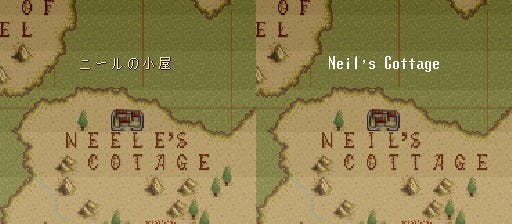
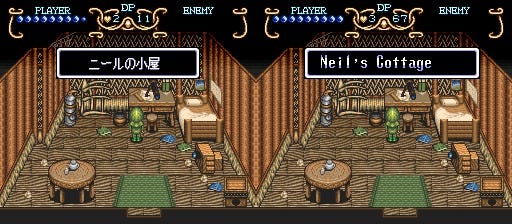

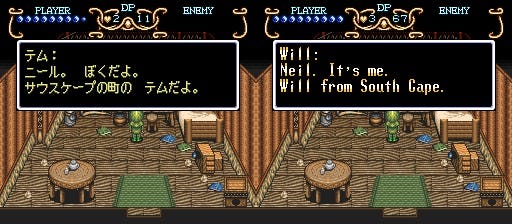

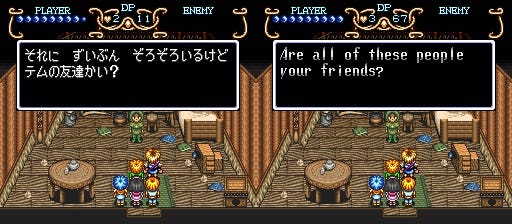
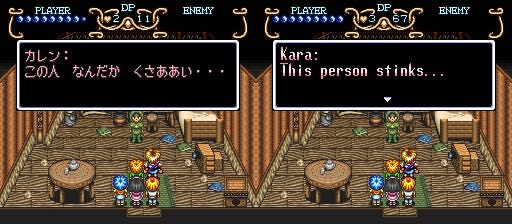
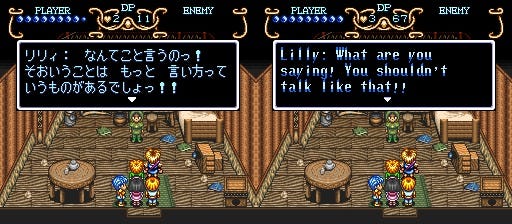


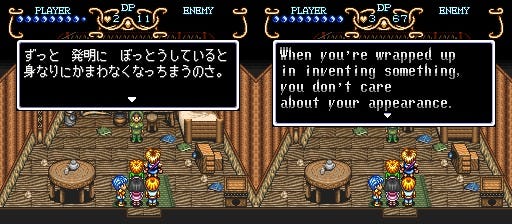

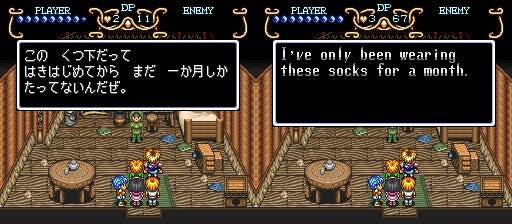

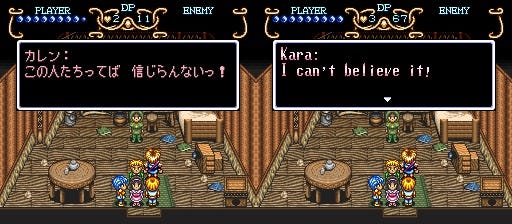
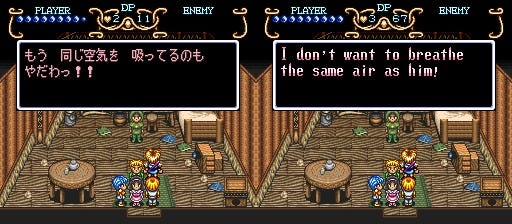
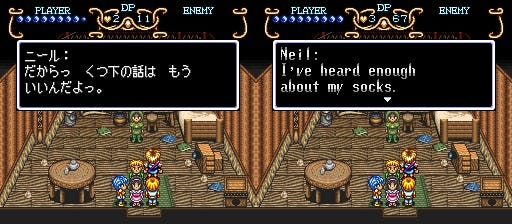
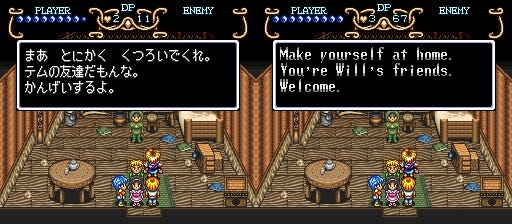


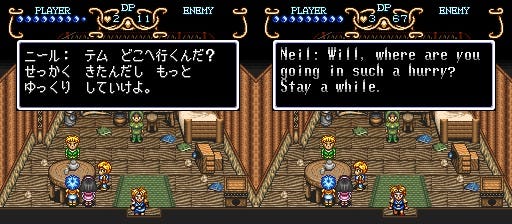
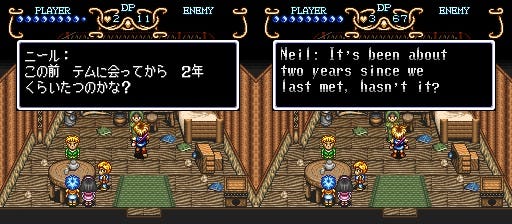

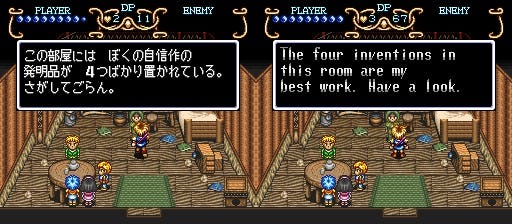
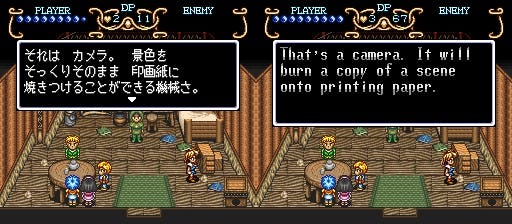

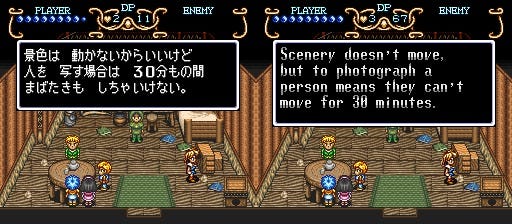

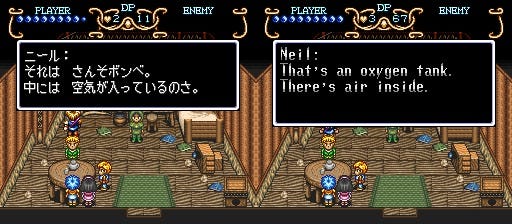

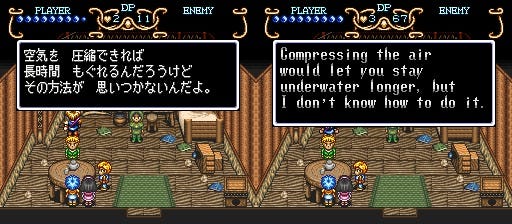
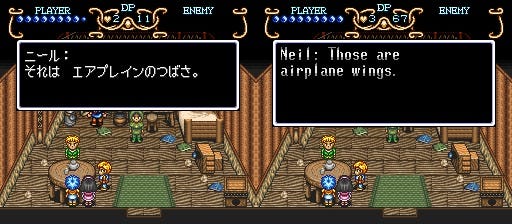
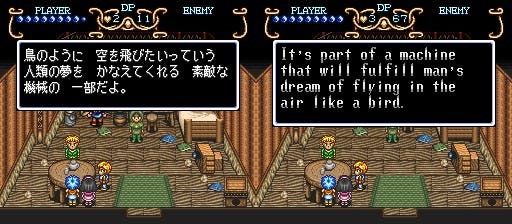

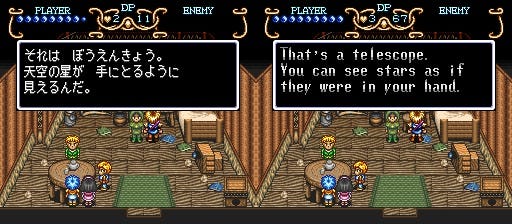
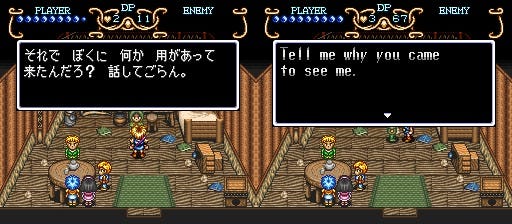


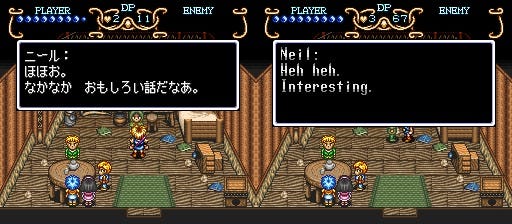

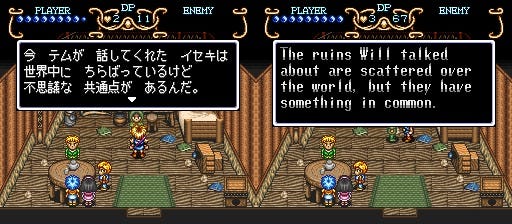
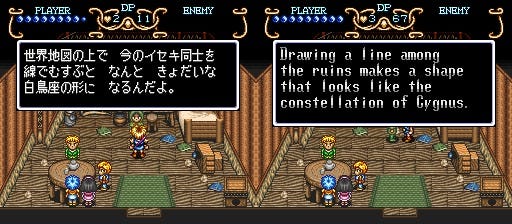
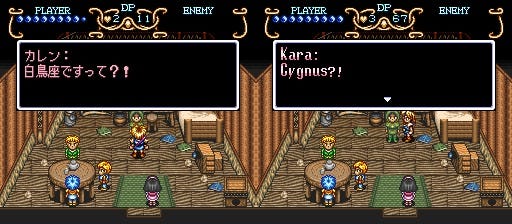
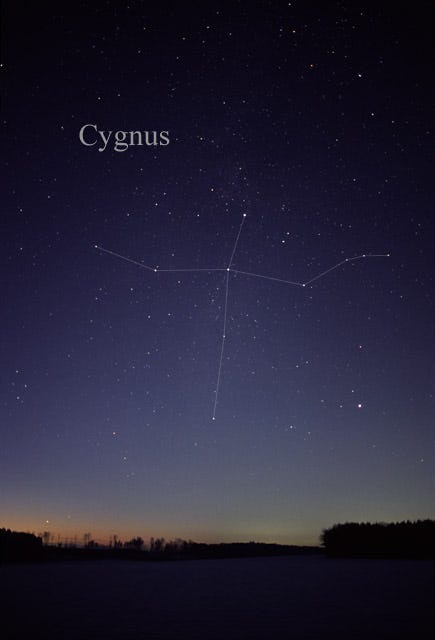




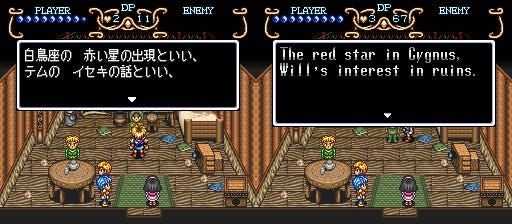

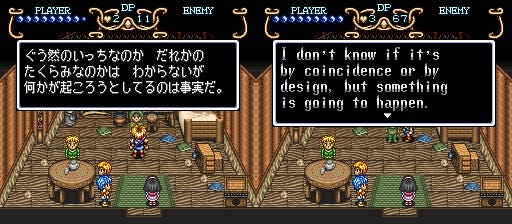

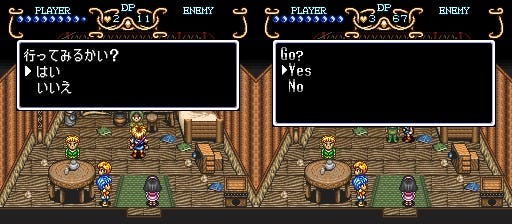
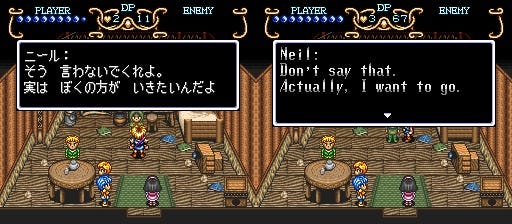
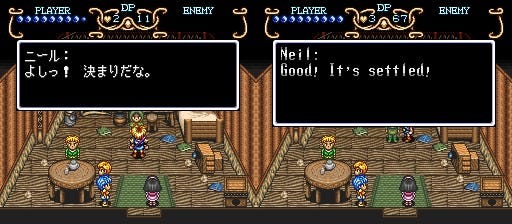


![The Condor[citation needed] The Condor[citation needed]](https://substackcdn.com/image/fetch/$s_!ipfD!,w_1456,c_limit,f_auto,q_auto:good,fl_progressive:steep/https%3A%2F%2Fsubstack-post-media.s3.amazonaws.com%2Fpublic%2Fimages%2F8e824c82-6f5e-4dd9-892a-f1cc7f71d066_1280x821.jpeg)





